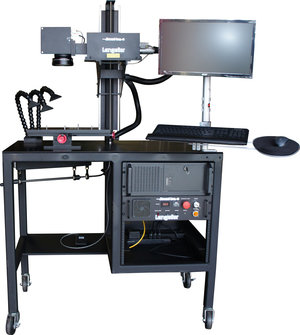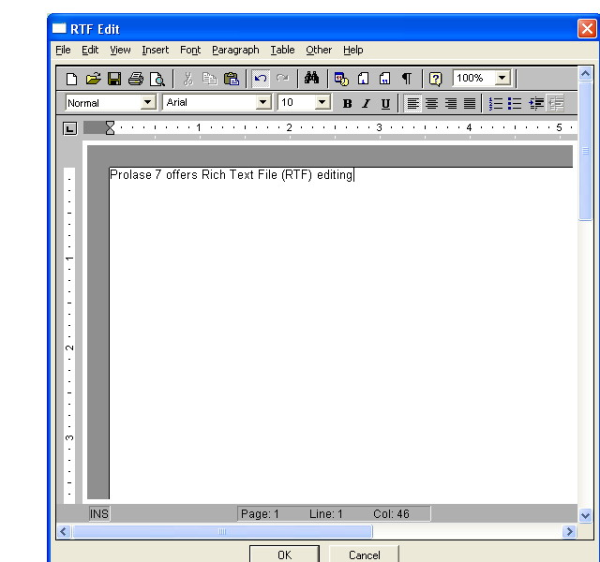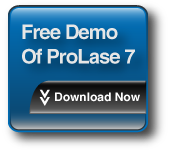Laser Marking Software - Prolase 7- Beta Version Evaluation - Post 1
This is is the 1st in an ongoing series of evaluation posts talking about the new release of...
By: Jim Earman on 12/14/10 9:12 AM

This is the 2nd in an ongoing series of evaluation posts talking about the new release of Prolase 7 from American Laserware.
We installed Prolase 7 on a production marker at Jimani. This marker was a Jimani Langolier with a 50 watt IPG fiber laser.
 V7 installed without any problems. I then copied my configuration files from the Prolase XP folder that was already on this marker. Keith from American Laserware, told me that since Prolase 7 does not install configuration (cfg) files so there is no danger of corrupting an existing installation if an updated version of Prolase 7 is installed over an existing version. I opened Prolase 7 and it was ready to go. All of the configuration info from Prolase XP was accepted by Prolase 7. I was able switch between Prolase 7 and Prolase XP on the same machine as long as I used a Prolase dongle that was enabled for both versions. Nice feature.
V7 installed without any problems. I then copied my configuration files from the Prolase XP folder that was already on this marker. Keith from American Laserware, told me that since Prolase 7 does not install configuration (cfg) files so there is no danger of corrupting an existing installation if an updated version of Prolase 7 is installed over an existing version. I opened Prolase 7 and it was ready to go. All of the configuration info from Prolase XP was accepted by Prolase 7. I was able switch between Prolase 7 and Prolase XP on the same machine as long as I used a Prolase dongle that was enabled for both versions. Nice feature.
The operators at Jimani were instructed to run new and existing production jobs on that machine and look for and report problems. Throughout the day the only problem reported was the inability to open a particular plt graphic file. Investigation of the file revealed that the file contained arcs. Standard plt files at Jimani don’t contain arcs but this one did. Prolase XP will accept plt files with arcs but the new plt importer in Prolase 7 did not. I reported this to American Laserware and was informed that the plt importer will be rewritten to accept plt files with arcs. Two days later I had an updated version of Prolase 7 and the plt importer was very happy with arcs.
Prolase 7 offers a Rich Text File (RTF) feature. In Prolase XP, a multi line Fixed Text object made using True Type fonts required that all lines in the object have the same properties. Different sizes of text or different fonts required separate Fixed Text objects. In Prolase 7 the Image tab on the Fixed Text properties pages allows the selection of either Simple Text or Rich Text. If Rich Text is selected, the Rich Text Editor pops up.

The Rich Text Editor allows a user to create multi line documents with full flexibility of True Type font selection and character size. Each line could be a different font and different size. After the Rich Text object is created, Prolase 7 allows all of the size, position and laser characteristics of the object to be controlled. According to American Laserware, the Rich Text feature will allow the marking of other character sets such as Hebrew or Chinese. We haven’t had an opportunity to test that feature yet.
So far, Prolase 7 appears to be stable enough that we are going to install it on all of the production markers at Jimani. There are no missing features in Prolase 7 that are available to us in Prolase XP but there are several features in V7 that we don’t have in XP. Our existing Prolase XP .laz files are loading and behaving perfectly well. We’ll continue running with Widows XP operating systems for the time being. There are more new features in the works for Prolase 7 and as they are released we want to get comfortable with them using Windows XP before we try out Prolase with a Windows 7 operating system.
I’ll add more to this Prolase 7 review as new features become available and we’ve had a chance to test them.
This is is the 1st in an ongoing series of evaluation posts talking about the new release of...
There are three or four good laser marking software packages on the market. They are all pretty...
Morgan Advanced Materials uses a wide range of specialist, high-specification materials that have...